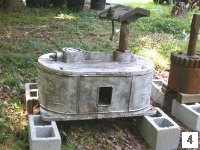Equipment
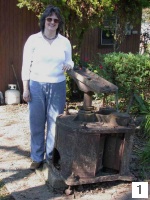 Two of my favorite articles are shown
in Slide 1: my spouse, Nedra, and a Goldens' 4xx (New Model), which I
purchased from the late Mr. John Cone (Mt. Pleasant, FL). This mill was used on a
farm near Chattahoochee (FL) until about 1983. Nedra was not very enthusiastic
about my discussing her specifications, but the 4xx was silent on this point. So,
. . . . The Goldens' 4xx was the largest vertical 3-roller animal-powered mill
that Goldens' initially made for domestic sales after the introduction of the New
Models in 1905 (as inferred from Catalog 38, ~1916). This is the only one that I have seen, so I
surmise that they must be rare, at least in this area. I am only aware of three
others, which are owned by Tommy
Clayton, John Catoe, and Bobby McDaniel.. Soon after the introduction of the
New Models, Goldens' made 4 standard 3-roller animal-powered mills (Nos. 1, 2, 3,
4) for domestic sales. In addition, they made an x-series by lengthening the
rollers. At least on the No. 2 and No. 2x, the top plates, except for the relief
lettering, were identical in size and mass. The same appeared to be true of other
parts, too, except for the components involved in lengthening the rollers (feed
box, panels, scrapers, guide knife, frame bolts). They also made an xx series
(Nos. 2xx, 3xx, 4xx), like this one, in which the top and bottom plates were
reinforced (note that the bottom plate has four hold-down bolts, instead of the
ordinary three). Other components of the mill were also made for heavy-duty
usage, such as brass bearings for the journal (which was oversized) of the king
roller, brass linings for the small rollers, and positive attachment of the gear
to the king rollers, instead of the simpler interlocking "clutch" mechanisms of
the other animal-powered mills. Overall, this mill was rated at 150 gallons per
hour and weighed 1385 pounds. These specifications were similar to the smallest
horizontal power mill--the No. 27 was rated at 125-175 gallons per hour and
weighed 1650 pounds. A portion of the mass of the No. 27 is for gears and pulley,
and indeed the rollers are larger on the No. 4xx (as they must be for the same
juice output, since the animal mills rotated more slowly). Sometime before1928
(Catalog 52, identical to Catalog
53), Goldens' discontinued the x- and xx-series, but made another heavy
series
Two of my favorite articles are shown
in Slide 1: my spouse, Nedra, and a Goldens' 4xx (New Model), which I
purchased from the late Mr. John Cone (Mt. Pleasant, FL). This mill was used on a
farm near Chattahoochee (FL) until about 1983. Nedra was not very enthusiastic
about my discussing her specifications, but the 4xx was silent on this point. So,
. . . . The Goldens' 4xx was the largest vertical 3-roller animal-powered mill
that Goldens' initially made for domestic sales after the introduction of the New
Models in 1905 (as inferred from Catalog 38, ~1916). This is the only one that I have seen, so I
surmise that they must be rare, at least in this area. I am only aware of three
others, which are owned by Tommy
Clayton, John Catoe, and Bobby McDaniel.. Soon after the introduction of the
New Models, Goldens' made 4 standard 3-roller animal-powered mills (Nos. 1, 2, 3,
4) for domestic sales. In addition, they made an x-series by lengthening the
rollers. At least on the No. 2 and No. 2x, the top plates, except for the relief
lettering, were identical in size and mass. The same appeared to be true of other
parts, too, except for the components involved in lengthening the rollers (feed
box, panels, scrapers, guide knife, frame bolts). They also made an xx series
(Nos. 2xx, 3xx, 4xx), like this one, in which the top and bottom plates were
reinforced (note that the bottom plate has four hold-down bolts, instead of the
ordinary three). Other components of the mill were also made for heavy-duty
usage, such as brass bearings for the journal (which was oversized) of the king
roller, brass linings for the small rollers, and positive attachment of the gear
to the king rollers, instead of the simpler interlocking "clutch" mechanisms of
the other animal-powered mills. Overall, this mill was rated at 150 gallons per
hour and weighed 1385 pounds. These specifications were similar to the smallest
horizontal power mill--the No. 27 was rated at 125-175 gallons per hour and
weighed 1650 pounds. A portion of the mass of the No. 27 is for gears and pulley,
and indeed the rollers are larger on the No. 4xx (as they must be for the same
juice output, since the animal mills rotated more slowly). Sometime before1928
(Catalog 52, identical to Catalog
53), Goldens' discontinued the x- and xx-series, but made another heavy
series-t.jpg) (Nos. 22, 33, 44, 55,
which weighed 1950 pounds) for domestic sales. I have never seen any of the
latter, but one No. 44x is shown on Snapshots. (This mill has been expertly restored by Anthony and Jerry Brinson.)
(Nos. 22, 33, 44, 55,
which weighed 1950 pounds) for domestic sales. I have never seen any of the
latter, but one No. 44x is shown on Snapshots. (This mill has been expertly restored by Anthony and Jerry Brinson.)
I purchased this Woodruff mill (Slide 2) from Mr. Robert Gay of the Boneville Historical District (near Augusta, Georgia), but I have subsequently traded it to Tommy Clayton. Through enormous effort and persistance, Don Dean discovered that a Woodruff Foundry in Winder, GA, made cane mills (among other items, such as this ornamental building column I found in Walhalla, South Carolina). I'll leave it to the reader to get the full account from Don's book.
I "rescued" these rollers (Slide 3) from the farm of the late Clifton and Flora Nix, longtime and respected farmers in eastern Berrien County, Georgia. (Thanks to their grandson and my attorney, Daniel L. Studstill). The larger rollers are 15 inches in diameter. The one with the journal for the lever cap weighs 245 pounds and the other, 215 pounds. The small rollers are 11 inches in diameter. The one with the journal for the lever caps weighs 140 pounds and the other, 120 pounds.
Goldens' Foundry and Machine Company made a bewildering array of small vertical and horizontal, two and three roller, horse and engine powered mills as one notes from perusing their catalog. However, this two-roller mill, the Goldens' No. 16 (New Model) (Slide 4), is the largest standard two-roller Goldens' mill that I have seen, though it is eclipsed by many of Goldens' export and long-roller mills. (Indeed, Goldens' promoted their three-roller mills, particularly in a horizontal configuration.) This mill requires two horses, has a juice output of 100 gallons per hour, and weighs 1160 pounds (the limit for a boom pole on my little 640 Ford tractor!). It appears that part of Goldens' capacity to produce so many different types of mills came from use of interchangeable parts. Thus, the king roller and associated bearings, the staves, and the lever cap appear to be interchangeable with the three roller Golden No. 4, and the same relationship seems to hold for the two-roller Golden No. 14 and Golden No. 3, and the two roller Golden No. 12 and the Golden No. 2. I have not had these parts laid out side by side, but make these inferences from catalogs. (I have, however, demonstrated to my satisfaction the interchangeability of parts of other Goldens' mills, which is addressed elsewhere.) (This mill has been expertly restored by Anthony and Jerry Brinson.)
This Southern Plow No. 5 (Slide 5)
originated near Enigma (Georgia) and was motorized by Merrice Hines (Tifton/Brooksfield, Georgia). It then traveled over
to Norman Park (Georgia) and subsequently found a temporary home in Covington
(Georgia) in a sorghum operation. I obtained it 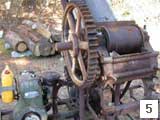 from Hilliard (Florida), but
later sold it to Charles Baldree (Omega, Georgia), who immediately sold it. The 8-hp
Wisconsin motor similarly has an illustrious personal history; Merrice salvaged
it off a garden tiller to use for this application. This 700-pound mill has
10-inch rollers and an advertised juice output of 120 gallons per hour, a value
that is consistent with that of the Goldens' No. 27, a horizontal power mill with
12-inch rollers and an advertised juice output of 125-175 gallons per hour. Tommy
Clayton pointed out that the Spotless Jumbo mill is identical to the Southern
Plow No. 5. The Spotless Company (Richmond, Virginia) had their mills produced in
an unspecified southern Ohio factory and advertised its capacity as 4-6 tons of
cane per 12 hours. At 70% extraction, this capacity would be only about 65
gallons per hour. (Thanks to Don Dean for the advertisement for the Spotless
Jumbo and Tommy Clayton for other information.)
from Hilliard (Florida), but
later sold it to Charles Baldree (Omega, Georgia), who immediately sold it. The 8-hp
Wisconsin motor similarly has an illustrious personal history; Merrice salvaged
it off a garden tiller to use for this application. This 700-pound mill has
10-inch rollers and an advertised juice output of 120 gallons per hour, a value
that is consistent with that of the Goldens' No. 27, a horizontal power mill with
12-inch rollers and an advertised juice output of 125-175 gallons per hour. Tommy
Clayton pointed out that the Spotless Jumbo mill is identical to the Southern
Plow No. 5. The Spotless Company (Richmond, Virginia) had their mills produced in
an unspecified southern Ohio factory and advertised its capacity as 4-6 tons of
cane per 12 hours. At 70% extraction, this capacity would be only about 65
gallons per hour. (Thanks to Don Dean for the advertisement for the Spotless
Jumbo and Tommy Clayton for other information.)
The first mill (Slide 6) that I
purchased was a Goldens' No. 2 (New Model). This particular mill is in excellent
condition, especially considering its manufacture before 1924 (on the basis of
guide-knife design). The paint matches the description of the original
paint. I paid much more than No. 2s go for, but the condition and the
emotional attachment have kept me from regretting the 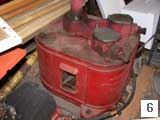 extravagance. (The emotional attachment is
linked to its being the kind of mill that I remember around syrup making.) Like most fans,
however, I can find reasons to support my devotion. I really do think the No. 2
is an excellent small mill; certainly, the farmers in this area felt so, since it
is so common. Although I have seen more No. 2s than any other kind of mill, I
have never seen one with a broken roller, broken gears, separated journal, or
broken base or top plates. I have certainly seen problems with other brands of
mills and even models of Goldens' (especially the x-series, which use shows are
not strong enough for the extended rollers.) I chose to restore for my own use a
Goldens' No. 2 (New Model), though one not in this excellent
condition.
extravagance. (The emotional attachment is
linked to its being the kind of mill that I remember around syrup making.) Like most fans,
however, I can find reasons to support my devotion. I really do think the No. 2
is an excellent small mill; certainly, the farmers in this area felt so, since it
is so common. Although I have seen more No. 2s than any other kind of mill, I
have never seen one with a broken roller, broken gears, separated journal, or
broken base or top plates. I have certainly seen problems with other brands of
mills and even models of Goldens' (especially the x-series, which use shows are
not strong enough for the extended rollers.) I chose to restore for my own use a
Goldens' No. 2 (New Model), though one not in this excellent
condition.
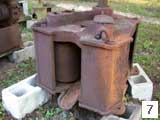 The Kentucky Bluegrass No. 4 (Louisville,
KY) is a large three-roller mill (Slide 7),
weighing 1200 pounds (thanks to Don Dean for this information). This one was
missing the journal lever cap, the feed box, the guide knife and the scrapers,
but replacements for these items can be fabricated. One journal lid and one of
the external-oiler lids is present, so duplicates for the missing ones can be
cast. Note the whole-box design for the king-roller journal. This mill was
located partially buried in the edge of the woods in Gadsden County (Florida),
and I bought it as part of a package deal and to "save it." My main interest is
in mills made in Georgia, particularly Goldens' mills, so I sold this mill to
Michael Strickland (Montgomery, AL). With such long rollers, this mill should
have a prodigious capacity when mechanized, as is planned by Michael.
The Kentucky Bluegrass No. 4 (Louisville,
KY) is a large three-roller mill (Slide 7),
weighing 1200 pounds (thanks to Don Dean for this information). This one was
missing the journal lever cap, the feed box, the guide knife and the scrapers,
but replacements for these items can be fabricated. One journal lid and one of
the external-oiler lids is present, so duplicates for the missing ones can be
cast. Note the whole-box design for the king-roller journal. This mill was
located partially buried in the edge of the woods in Gadsden County (Florida),
and I bought it as part of a package deal and to "save it." My main interest is
in mills made in Georgia, particularly Goldens' mills, so I sold this mill to
Michael Strickland (Montgomery, AL). With such long rollers, this mill should
have a prodigious capacity when mechanized, as is planned by Michael.
The Goldens' No. 1 (New Model, Slide 8)
is the smallest of the Goldens' mills, weighing only 375 pounds and having
5-inch-long rollers. Ken Womble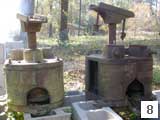 suggested it
might look nice on a charm bracelet! In the Goldens' 1-4 series, the roller
length and small-roller diameter increase by 1 inch, whereas the king
roller-diameter increases by 2 inches. As expected, the mass increases in this
series more than linearly with roller length (because the top and bottom increase
as a square function related to roller diameter); thus, the ratios, overall-
mass/roller-length, are 75, 95, 110, and137 pounds/inch, respectively. The mill
on the left originated in Jefferson County (Florida) and I purchased the mill on
the right from Wakulla County (Florida). The king journal of the mill on the
right is about 1.25 inches taller than the one on the left. As a complementary
observation, Tommy Clayton has noted different journal lengths in Chattanooga No.
12s. I have and will keep one of these mills; the other was sold to Joe Feagle of
Keystone Heights (Florida). (The four-hour barbeque job--note smoke at left--gave
me plenty of time to photograph.)
suggested it
might look nice on a charm bracelet! In the Goldens' 1-4 series, the roller
length and small-roller diameter increase by 1 inch, whereas the king
roller-diameter increases by 2 inches. As expected, the mass increases in this
series more than linearly with roller length (because the top and bottom increase
as a square function related to roller diameter); thus, the ratios, overall-
mass/roller-length, are 75, 95, 110, and137 pounds/inch, respectively. The mill
on the left originated in Jefferson County (Florida) and I purchased the mill on
the right from Wakulla County (Florida). The king journal of the mill on the
right is about 1.25 inches taller than the one on the left. As a complementary
observation, Tommy Clayton has noted different journal lengths in Chattanooga No.
12s. I have and will keep one of these mills; the other was sold to Joe Feagle of
Keystone Heights (Florida). (The four-hour barbeque job--note smoke at left--gave
me plenty of time to photograph.)
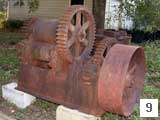 As stated in several places before, Goldens'
mills are the most common extant mills in this area. The second most common
vertical mills were made by Chattanooga or Columbus/Southern Plow, perhaps some
more of the latter. Interestingly, however, there is only a smattering of
Chattanooga power mills, but relatively abundant Columbus power mills.
This Chattanooga No. 72 (Slide 9), patent date of 1897, was found in Gadsden County
(Florida), but it appears to have changed hands before landing there, and was
part of the property during a real-estate transfer, so I do not know its
provenance. Based on a 12 x 12 inch king roller, as is the Chattanooga No. 92, it
weighs 2100 and was advertised to produce 1500-2000 gallons of juice a day. The
No. 92 is double-geared, weighs 2750 pounds, and produces 2000-2500 gallons of
juice a day; only the No. 92 was offered in a late catalog that I had access to.
This mill was sold to Charles Baldree (Omega, GA), who restored it for a 35-acre cane
operation near Albany, GA.
As stated in several places before, Goldens'
mills are the most common extant mills in this area. The second most common
vertical mills were made by Chattanooga or Columbus/Southern Plow, perhaps some
more of the latter. Interestingly, however, there is only a smattering of
Chattanooga power mills, but relatively abundant Columbus power mills.
This Chattanooga No. 72 (Slide 9), patent date of 1897, was found in Gadsden County
(Florida), but it appears to have changed hands before landing there, and was
part of the property during a real-estate transfer, so I do not know its
provenance. Based on a 12 x 12 inch king roller, as is the Chattanooga No. 92, it
weighs 2100 and was advertised to produce 1500-2000 gallons of juice a day. The
No. 92 is double-geared, weighs 2750 pounds, and produces 2000-2500 gallons of
juice a day; only the No. 92 was offered in a late catalog that I had access to.
This mill was sold to Charles Baldree (Omega, GA), who restored it for a 35-acre cane
operation near Albany, GA.
Parts of a disassembled Goldens' No. 2 (old
style) are propped on an assembled mill of the same type (Slide 10). There
were several small foundries in Columbus as early as the 1840s. Indeed, one was
the Columbus Iron 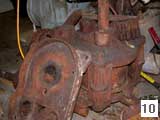 Foundry and
unofficially the Columbus Iron Works was set up in 1848 as a working combination
of several foundries, including (G.P.) Golden's Machine Shop. The Columbus Iron
Works was officially organized in 1853 and shortly after the war, G.P Golden was
a major figure in the organization. G.P.'sons, J.P. and T.E., started their
business, along with a partner, in 1882 and incorporated as Goldens' Foundry and Machine Company
in 1889. By 1884, the Golden Brothers were making animal and steam-powered cane
mills, evaporators and shallow-patterned syrup kettles. As far as I am aware,
there are no extant catalogs of Golden mills prior to the introduction of the New
Models (1905), and there are very few of the old-style mills ("The Golden Mill").
I have never seen one of their earlier horizontal power mills; Don Dean owns two of
the old-style 2-roller mills and Tommy
Clayton owns a No. 1 and a No. 4 old-style mill. In a separate photo-essay, I
will compare the No. 2 (old style) and the No. 2 (New Model), a superior mill in
my opinion. The disassembled mill was a generous gift of Charles Deese (Wellborn, Florida) and the assembled mill originated
near Tampa (Florida), but I bought it from southeast of Orlando (Florida).
(Thanks to Dennis Parker, who provided a copy of The First Hundred Years
1882-1982, a History of Goldens' Foundry & Machine Company by J.P. Golden
II, from which some of this material was taken.)
Foundry and
unofficially the Columbus Iron Works was set up in 1848 as a working combination
of several foundries, including (G.P.) Golden's Machine Shop. The Columbus Iron
Works was officially organized in 1853 and shortly after the war, G.P Golden was
a major figure in the organization. G.P.'sons, J.P. and T.E., started their
business, along with a partner, in 1882 and incorporated as Goldens' Foundry and Machine Company
in 1889. By 1884, the Golden Brothers were making animal and steam-powered cane
mills, evaporators and shallow-patterned syrup kettles. As far as I am aware,
there are no extant catalogs of Golden mills prior to the introduction of the New
Models (1905), and there are very few of the old-style mills ("The Golden Mill").
I have never seen one of their earlier horizontal power mills; Don Dean owns two of
the old-style 2-roller mills and Tommy
Clayton owns a No. 1 and a No. 4 old-style mill. In a separate photo-essay, I
will compare the No. 2 (old style) and the No. 2 (New Model), a superior mill in
my opinion. The disassembled mill was a generous gift of Charles Deese (Wellborn, Florida) and the assembled mill originated
near Tampa (Florida), but I bought it from southeast of Orlando (Florida).
(Thanks to Dennis Parker, who provided a copy of The First Hundred Years
1882-1982, a History of Goldens' Foundry & Machine Company by J.P. Golden
II, from which some of this material was taken.)
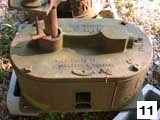 The Goldens' No 12 (Slide 11) is the
smallest of the enclosed-framed 2-roller New Model mills produced by the foundry
after 1905. As mentioned on the narrative for Slide 1, some parts of this mill
are interchangeable with the Goldens' No. 2. With a mass just slightly larger
than the No. 2, Golden's rated it as a heavy 1-horse mill with a juice output of
45 gallons per hour, the same as the No. 2.
The Goldens' No 12 (Slide 11) is the
smallest of the enclosed-framed 2-roller New Model mills produced by the foundry
after 1905. As mentioned on the narrative for Slide 1, some parts of this mill
are interchangeable with the Goldens' No. 2. With a mass just slightly larger
than the No. 2, Golden's rated it as a heavy 1-horse mill with a juice output of
45 gallons per hour, the same as the No. 2.
This massive mill (Slide 12)
was made by Rourke Iron Works in Savannah, Georgia. John Rourke and Son had a
thriving business as judged from their factory image on an 1893 letterhead. The company made cane mills, pans, and boilers
and were dealers fo_side_t.jpg) r items that they did not make. The rollers of this mill are
18 inches in
diameter and 14 inches tall. I could not determine the weight, but my 300-lb fish
scale
bottomed out before lifting the short-journal roller off the ground. I
obtained this mill through Charles Taylor (North Carolina) but picked it up from
Baxley (Georgia). As I am told, it was part of a syrup operation near Macon
(Georgia). Interestingly, the bearings had rotted out, presumably being wood
replacements for the originals.
r items that they did not make. The rollers of this mill are
18 inches in
diameter and 14 inches tall. I could not determine the weight, but my 300-lb fish
scale
bottomed out before lifting the short-journal roller off the ground. I
obtained this mill through Charles Taylor (North Carolina) but picked it up from
Baxley (Georgia). As I am told, it was part of a syrup operation near Macon
(Georgia). Interestingly, the bearings had rotted out, presumably being wood
replacements for the originals.
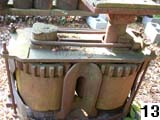 Morven Foundry and Machine Co. (Morven, Georgia)
produced cane mills for a few years around the turn of the twentieth century.
These mills (Slide
13) are essentially the same as those produced by several other Georgia
foundries. They are also similar to other mills made elsewhere with slight
modifications (e.g., in roller-adjustment mechanism). Although there were
foundries in Valdosta (Georgia) that produced cane mills, Morven is a touch
closer to my hometown of Nashville (Georgia), and these mills therefore take on
special meaning to me. Their antiquity and relative scarcity adds further to that
meaning, so when I had an opportunity to buy a second mill, I jumped
at it. Between these two mills, I plan to assemble a completely original mill,
down to the last nut.
Morven Foundry and Machine Co. (Morven, Georgia)
produced cane mills for a few years around the turn of the twentieth century.
These mills (Slide
13) are essentially the same as those produced by several other Georgia
foundries. They are also similar to other mills made elsewhere with slight
modifications (e.g., in roller-adjustment mechanism). Although there were
foundries in Valdosta (Georgia) that produced cane mills, Morven is a touch
closer to my hometown of Nashville (Georgia), and these mills therefore take on
special meaning to me. Their antiquity and relative scarcity adds further to that
meaning, so when I had an opportunity to buy a second mill, I jumped
at it. Between these two mills, I plan to assemble a completely original mill,
down to the last nut.
I am progressing well into my second childhood,
else I would not relate the following story out of concern that a reader would
discount it or, worse, mistakenly infer that I had lost my devotion to the truth.
But, in one's second childhood, scant attention is paid to such matters. I will,
at least, make it a short story (so it cannot be thought a big lie). I received a
note from Ken Christison on Friday, January 28, 2005, that began "Since I am sure
you haven't seen a cane mill you didn't like, and I know you are interested in
mills made in GA, I am passing on this info to you." Peggie Barrentine (Enigma,
Georgia; half of Enigma, other
half) had found Ken's syrupmakers website and contacted him a week earlier in
an effort to give away a cane mill! Owing to the distance, Ken was unable to get
it himself, so I came to his mind. I contacted her immediately and found a
clearing in the rain on Saturday and the mill was in my backyard later that day.
The mill came Peggie's way through inheritance from her parents (Ralph J. and
Lillian Sumner), who had bought the property on which the mill sat from Wyche
Allen in 1957. Berrien-County farmer John D. Allen (1867-) and his wife Isadora
(1873-) were the parents of Wyche D. Allen (b. 1896). In turn, Wyche was the
grandfather of my classmate, Harold Allen, Jr., whose FFA steers always took top
honors, thus outclassing mine and all others. Peggie--whom I had not seen in 40+
years--was also of my age, and incredibly, her husband, Bentley, grew up in part
in the very same house that my family lived in in Enigma when my father
was principal there. The mill was located within a couple of miles of that house
an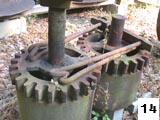 d it is quite possible that I went to a cane grinding there (Daddy
was a people person and we never missed a cane grinding, a fish fry, a church
dinner and if there was ever a crowd of two or more people in Berrien County, you
could count on Daddy being one, whether at the post office, a store . . . .) What
a small world! The mill was a frameless McDonough-Ballantyne (Slide
14). As indicated elsewhere (Snapshot 78), how syrupmakers put these mills into custom wooden
frames is of interest, so I refer you to different views of the feed side
(1, 2), of the discharge side, of the upper box (other end), the lower
box, and a close-up of one of the mortise and tenon joints. As good as this luck was, it didn't
stop: I was building on Daddy's habit of stopping with folks and saw Ronnie
Gaskins and Larry Watson, my cousin, who was feeding his horse. Since I will
carry on about Ronnie elsewhere, I will cut to the chase and simply allow that
that conversation ended with my being given a second
mill like this one. Naturally, questions about the history of the company
came to mind and I am grateful to have found a very conscientious librarian, from
whose notes I extract. Neither a likely McDonough nor Ballantyne was found in
Savannah (the site of the foundry) before the War. However, a John McDonough was
found as a lumber merchant in the 1867 city directory. The 1870 census listed a
John McDonough as a wealthy 49-year-old Irishman, who was a manufacturer. He had
five children, all born in Georgia, with the oldest being 23. One son, John, was
listed as a lumber merchant, and it may be he, albeit at a tender age, or his
father in the 1867 city directory. McDonough and Ballantyne Iron and Brass
Foundry and Machine Shop had a prominent advertisement in the 1870 city directory, which noted that the business had moved to a
second location, clearly indicating that the foundry was established well before
1870, and possibly predating Kehoe, S.W. Gleason, and Rourke foundries (see a Savannah promotional ). This directory included the first
listing of a Thomas Ballantyne, a moulder and engineer who was born in 1835 in
Scotland. In 1871, again McDonough and Ballantyne had an advertisement and elsewhere in this directory, John McDonough was
given a large write up, which showed him with three businesses (the foundry, as
mentioned; John McDonough & Sons (planing mills; "sons" = John J. and Henry
A.); and one unspecified). At some time, McDonough moved to Auburndale, Florida,
and when he died in 1884, his body was brought back for burial in Catholic
Cemetery. In 1891, his son John J. was listed as one of the co-owners of the business. Ballantyne, who apparently did not
marry, died in Florida in 1903 and his body too was returned to Savannah and
interred in Laurel Grove Cemetery. McDonough and Ballantyne was not listed in the
city directory after 1903. (Of course, I am much obliged to Peggie Barrentine and
Ronnie Gaskins for the kind gifts of the mills. Very special thanks to Sharen Lee
(Live Oak Public Libraries, Savannah, Georgia) for her searching in depth in
response to my several requests. As is often the case, Ken Christison provided
essential assistance, which I continue to appreciate.)
d it is quite possible that I went to a cane grinding there (Daddy
was a people person and we never missed a cane grinding, a fish fry, a church
dinner and if there was ever a crowd of two or more people in Berrien County, you
could count on Daddy being one, whether at the post office, a store . . . .) What
a small world! The mill was a frameless McDonough-Ballantyne (Slide
14). As indicated elsewhere (Snapshot 78), how syrupmakers put these mills into custom wooden
frames is of interest, so I refer you to different views of the feed side
(1, 2), of the discharge side, of the upper box (other end), the lower
box, and a close-up of one of the mortise and tenon joints. As good as this luck was, it didn't
stop: I was building on Daddy's habit of stopping with folks and saw Ronnie
Gaskins and Larry Watson, my cousin, who was feeding his horse. Since I will
carry on about Ronnie elsewhere, I will cut to the chase and simply allow that
that conversation ended with my being given a second
mill like this one. Naturally, questions about the history of the company
came to mind and I am grateful to have found a very conscientious librarian, from
whose notes I extract. Neither a likely McDonough nor Ballantyne was found in
Savannah (the site of the foundry) before the War. However, a John McDonough was
found as a lumber merchant in the 1867 city directory. The 1870 census listed a
John McDonough as a wealthy 49-year-old Irishman, who was a manufacturer. He had
five children, all born in Georgia, with the oldest being 23. One son, John, was
listed as a lumber merchant, and it may be he, albeit at a tender age, or his
father in the 1867 city directory. McDonough and Ballantyne Iron and Brass
Foundry and Machine Shop had a prominent advertisement in the 1870 city directory, which noted that the business had moved to a
second location, clearly indicating that the foundry was established well before
1870, and possibly predating Kehoe, S.W. Gleason, and Rourke foundries (see a Savannah promotional ). This directory included the first
listing of a Thomas Ballantyne, a moulder and engineer who was born in 1835 in
Scotland. In 1871, again McDonough and Ballantyne had an advertisement and elsewhere in this directory, John McDonough was
given a large write up, which showed him with three businesses (the foundry, as
mentioned; John McDonough & Sons (planing mills; "sons" = John J. and Henry
A.); and one unspecified). At some time, McDonough moved to Auburndale, Florida,
and when he died in 1884, his body was brought back for burial in Catholic
Cemetery. In 1891, his son John J. was listed as one of the co-owners of the business. Ballantyne, who apparently did not
marry, died in Florida in 1903 and his body too was returned to Savannah and
interred in Laurel Grove Cemetery. McDonough and Ballantyne was not listed in the
city directory after 1903. (Of course, I am much obliged to Peggie Barrentine and
Ronnie Gaskins for the kind gifts of the mills. Very special thanks to Sharen Lee
(Live Oak Public Libraries, Savannah, Georgia) for her searching in depth in
response to my several requests. As is often the case, Ken Christison provided
essential assistance, which I continue to appreciate.)
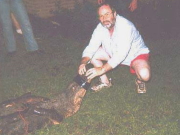
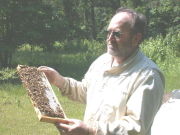
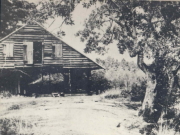
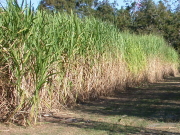
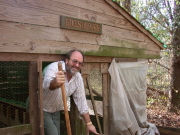
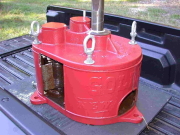
-t.jpg)
